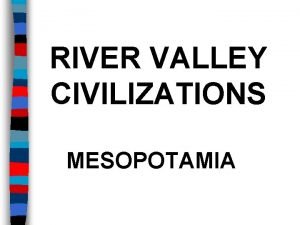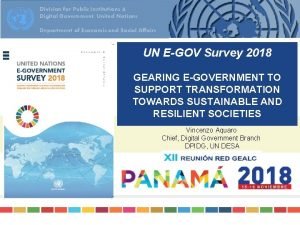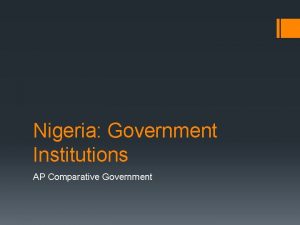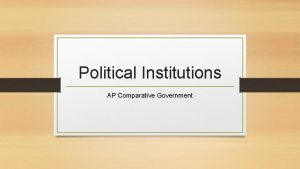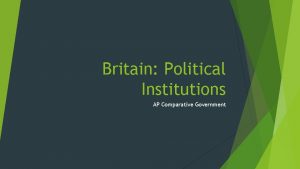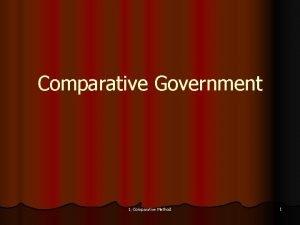CHINA INSTITUTIONS OF GOVERNMENT AP Comparative Government PARALLEL








- Slides: 8

CHINA: INSTITUTIONS OF GOVERNMENT AP Comparative Government

PARALLEL HIERARCHIES • The political structure of the People’s Republic of China can best be seen as three parallel hierarchies that are separate yet interact. They include the: • Communist Party • State or government • People’s Liberation Army • The party dominates all three arms of government, but they are considered to be separate entities • The control of the party and government is described as dual role • Vertical supervision of the next higher level of government • Horizontal supervision of the Communist Party at the same level • While the structure of government closely mirrors Russia, Chinese policy making is determined more through factions than through strict control through a main leader

STRUCTURE • The government structure of the People’s Republic of China has three branches: • Legislature • Executive • Judiciary • All Branches are controlled party, so they are not independent, nor do they have a system checks and balances • All top positions are held by party members, as are the majority of lower level positions

PEOPLE’S CONGRESS • The National People’s Congress has the formal authority in China • The National People’s Congress is at the top of the hierarchy. They are followed by provincial, city and local congresses • The National People’s Congress chooses the president and vice president of China, but there is only one party-sponsored candidate for each position • The National People’s Congress has very little power, but they are important because it is through these meetings where the Politburo’s decisions are announced

EXECUTIVE/BUREAUCRACY • The president and vice president serve five-year terms and are limited to two terms • To be president you must be at least 45 years old • The positions are largely ceremonial, but party leaders have always held them • Currently Xi Jinping is both the president and the general secretary of the CCP • He is expected to serve two five year terms and serve as president until 2023 • The premier is the head of government, formally appointed by the president • This position is also always held by a member of the Standing Committee • The current premier is Li Keqiang • He directs the State Council, which is composed of ministers who direct the many ministries and commissions of the bureaucracies • The Bureaucracy exists on all levels, national, provincial, county and local • Lower level positions are held by cadres, people in positions of authority who are paid by the government or party

JUDICIARY • China has a four-tiered “people’s court” system, organized hierarchically just as the people's congresses are • The people‘s procuratorate provides public prosecutors and defenders to the courts • Under Mao, the concept of rule of law had very little impact, but after 1978 Chinese leaders began to develop new legal ideas and institutions that included rule of law • The concept of rule of law in China is interpreted to mean that laws bind behavior and all are equally subject to them • These principles are however not always applied • Those who dissent against the government are commonly arrested and placed in jail without having their charges announced and without trial • The conviction rate in China is 99% • Prison terms are long and subject to little appeal • Execution for crimes are common in China

THE PEOPLE’S LIBERATION ARMY (PLA) • The People’s Liberation Army encompasses all of the country's ground, air, and naval armed services • There are 3 million active personnel and about 12 million reserves • The military is represented in the government by the Central Military Commission • The military has cut off connections with other militaries

POLICYMAKING • Since Deng Xioping, policymaking has focused on reconciling centralized political authority, with marketization and privatization • China has been able to thus far resist the need to democratize even though there has been large changes in the newly capitalist nature of the Chinese economy
 Complex institutions in mesopotamia
Complex institutions in mesopotamia Division for public institutions and digital government
Division for public institutions and digital government Comparative development experiences of india and china
Comparative development experiences of india and china Non parallel sentence
Non parallel sentence What is like parallel forces
What is like parallel forces Parallel structure means using the same pattern of
Parallel structure means using the same pattern of What are the two focal points of a loop?
What are the two focal points of a loop? Serial in serial out shift register truth table
Serial in serial out shift register truth table Annie's dress was old, faded, and it had wrinkles.
Annie's dress was old, faded, and it had wrinkles.
